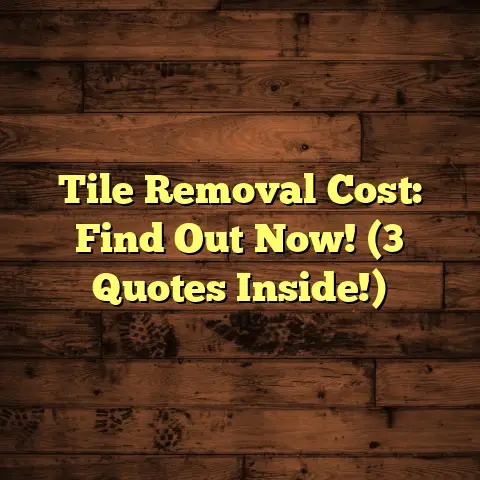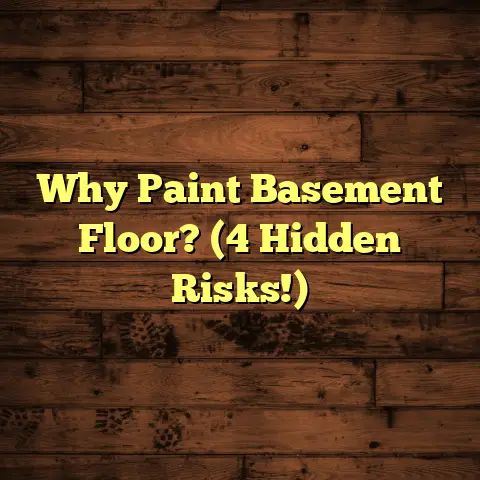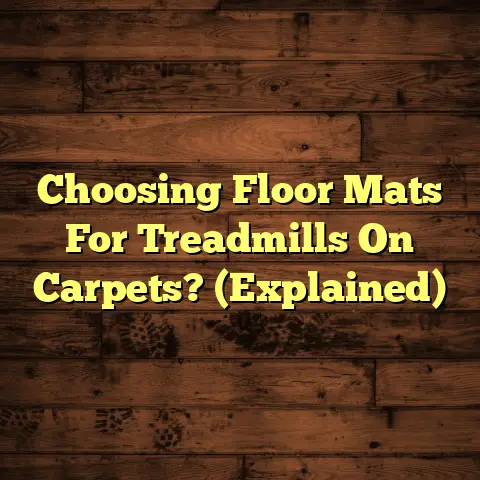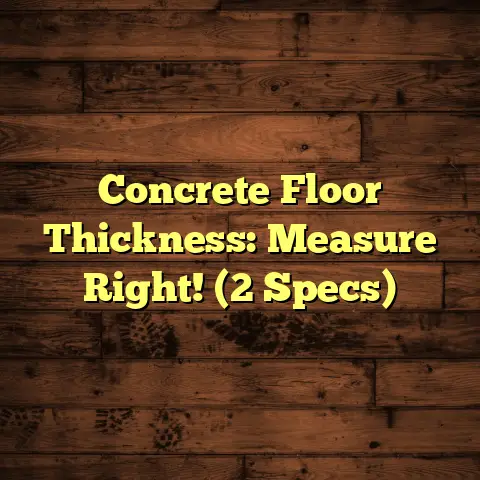Linoleum Scuff Removal? (2 Minute Fix!)
Ever walked into a room and noticed those unsightly scuff marks on your linoleum floor?
They’re like little gremlins, constantly popping up and ruining the otherwise pristine look of your space.
Trust me, I’ve been there!
As a flooring contractor
for over 15 years, I’ve seen it all.
Scuffs are a common enemy, but fear not!
I’m here to share a few quick and effective solutions that can banish those marks in minutes.
Ready to get started? Let’s dive in!
Section 1: Safety First
Before we jump into the nitty-gritty of scuff removal,
let’s talk safety.
I know, it’s not the most exciting
topic, but it’s crucial.
Importance of Safety
When dealing with any home maintenance task, safety should always be your top priority.
Cleaning supplies, while effective, can sometimes contain harsh chemicals that can irritate your skin, eyes, or respiratory system.
Plus, you might be using tools that could potentially cause injury if not handled properly.
Protective Gear
First things first, grab a pair of gloves.
I personally prefer nitrile gloves because they’re
resistant to most household chemicals and offer
a good grip.
Next up, consider eye protection.
While it might seem overkill for simple scuff removal, splashes can happen, especially when you’re working with liquids.
A simple pair of safety goggles will do the trick.
Ventilation
Whenever you’re using cleaning products, make sure the area is well-ventilated.
Open a window or turn on a fan to circulate the air.
This is especially important if you’re using commercial cleaners that may emit fumes.
I always crack a window, even if it’s just a little bit.
Child and Pet Safety
This one’s a no-brainer, but I have to mention it.
Keep children and pets away from the area while
you’re cleaning.
Curious little ones (and furry friends)
can easily get into trouble with cleaning supplies.
Store all products out of their reach, preferably in a locked cabinet.
Section 2: Understanding Linoleum Flooring
Now that we’ve covered safety, let’s talk about
linoleum itself.
Understanding its composition and
characteristics will help you choose the right
scuff removal method.
Composition and Characteristics
Linoleum is a resilient flooring material made from natural ingredients like linseed oil, rosin, cork dust, wood flour, and mineral fillers.
These materials are pressed onto a burlap or canvas backing, creating a durable and eco-friendly flooring option.
Linoleum is known for its durability, water resistance,
and vibrant colors.
It’s also naturally antibacterial,
making it a popular choice for kitchens, bathrooms,
and other high-traffic areas.
According to the North American Association of Floor Covering Installers (NAFCI), linoleum can last for 20-40 years with proper maintenance.
Common Causes of Scuffs
So, what causes those pesky scuff marks in the
first place?
Well, there are several culprits:
- Furniture: Moving chairs, tables, or other furniture across the floor can leave scuff marks, especially if the furniture legs don’t have protective pads.
- Shoes: Shoes with hard soles or heels can easily scuff linoleum, especially in high-traffic areas like entryways.
- Everyday Wear and Tear: Over time, normal foot traffic and everyday activities can cause scuff marks to accumulate.
- Dragging Objects: Dragging heavy objects across the floor is a surefire way to create scuffs and even scratches.
Why Prompt Removal is Important
Leaving scuffs untreated can lead to more serious
problems down the road.
Over time, scuff marks can
become embedded in the linoleum, making them
harder to remove.
Plus, dirt and grime can accumulate in the scuffed areas, leading to discoloration and dullness.
In some cases, untreated scuffs can even damage the linoleum’s protective coating, making it more vulnerable to stains and wear.
According to a study by the Institute of Inspection, Cleaning and Restoration Certification (IICRC), regular cleaning and maintenance can extend the life of your linoleum flooring by up to 50%.
Section 3: Quick Fix Methods for Linoleum Scuff Removal
Alright, let’s get to the good stuff!
Here are
five quick and effective methods for removing
scuff marks from your linoleum floor:
Method 1: Eraser Method
This is my go-to method for light scuff marks.
All you need is a standard rubber eraser, like
the ones you used in school.
Step-by-Step Instructions:
- Make sure the area is clean and dry.
- Gently rub the eraser back and forth over the scuff mark, applying light pressure.
- Continue rubbing until the scuff mark disappears.
- Wipe away any eraser residue with a clean, damp cloth.
Tips for Effectiveness:
- Use a clean eraser to avoid transferring dirt or smudges onto the floor.
- Apply even pressure to avoid damaging the linoleum.
- For stubborn scuff marks, try using a slightly abrasive eraser, like a pencil eraser.
Precautions:
- Avoid using erasers with harsh chemicals or abrasives, as they can damage the linoleum’s surface.
- Test the eraser on an inconspicuous area first to ensure it doesn’t cause any discoloration or damage.
Method 2: Vinegar and Water Solution
Vinegar is a natural cleaning agent that can work
wonders on linoleum scuff marks.
Its mild acidity
helps break down the scuff marks without damaging
the floor.
Recipe:
- 1/2 cup white vinegar
- 1 gallon warm water
Process:
- Mix the vinegar and water in a bucket.
- Dip a clean cloth or sponge into the solution.
- Wring out the cloth to avoid oversaturating the floor.
- Gently scrub the scuff marks with the damp cloth.
- Rinse the area with clean water.
- Dry the floor with a clean towel.
Tips for Effectiveness:
- Use distilled white vinegar for best results.
- Avoid using too much vinegar, as it can dull the linoleum’s finish.
- For stubborn scuff marks, let the vinegar solution sit on the affected area for a few minutes before scrubbing.
Precautions:
- Always test the vinegar solution on an inconspicuous area first to ensure it doesn’t cause any discoloration or damage.
- Avoid using vinegar on linoleum floors that have a wax finish, as it can strip the wax.
Method 3: Baking Soda Paste
Baking soda is a mild abrasive that can help remove stubborn scuff marks without scratching the linoleum.
Recipe:
- 1/4 cup baking soda
- 2 tablespoons water
Instructions:
- Mix the baking soda and water in a small bowl to form a paste.
- Apply the paste to the scuff marks.
- Gently scrub the area with a soft cloth or sponge.
- Rinse the area with clean water.
- Dry the floor with a clean towel.
Tips for Effectiveness:
- Use a non-abrasive cloth or sponge to avoid scratching the linoleum.
- For stubborn scuff marks, let the baking soda paste sit on the affected area for a few minutes before scrubbing.
Precautions:
- Avoid using too much baking soda, as it can leave a residue on the floor.
- Test the baking soda paste on an inconspicuous area first to ensure it doesn’t cause any discoloration or damage.
Method 4: Commercial Cleaners
If you’re dealing with particularly stubborn scuff marks, you might want to try a commercial cleaner specifically designed for linoleum floors.
There are many great products on the market, but here are a few of my favorites:
- Armstrong Once ‘n Done Resilient & Ceramic Floor Cleaner: This cleaner is designed to remove dirt and grime without leaving a residue.
- Bona Stone, Tile & Laminate Floor Cleaner: While technically designed for stone, tile, and laminate, this cleaner is also safe and effective on linoleum.
- Rejuvenate Luxury Vinyl Floor Cleaner: This cleaner is specifically formulated for luxury vinyl, but it can also be used on linoleum to remove scuff marks and restore shine.
Application Methods:
- Follow the manufacturer’s instructions carefully.
- Apply the cleaner to the scuff marks using a clean cloth or mop.
- Gently scrub the area to remove the scuff marks.
- Rinse the area with clean water.
- Dry the floor with a clean towel.
Cautions:
- Always read and follow the manufacturer’s instructions carefully.
- Test the cleaner on an inconspicuous area first to ensure it doesn’t cause any discoloration or damage.
- Avoid using cleaners that contain harsh chemicals or abrasives, as they can damage the linoleum’s surface.
Method 5: Heat Application
This method involves using a hairdryer or heat gun to soften the scuff marks, making them easier to remove.
Instructions:
- Set the hairdryer or heat gun to a low setting.
- Hold the heat source a few inches away from the scuff mark.
- Move the heat source back and forth over the scuff mark for a few seconds.
- Gently wipe the softened scuff mark with a clean cloth.
- Repeat the process until the scuff mark is removed.
Tips for Effectiveness:
- Use a low heat setting to avoid damaging the linoleum.
- Don’t hold the heat source in one spot for too long, as this can cause the linoleum to melt or discolor.
- Be careful not to burn yourself.
Precautions:
- Always test the heat on an inconspicuous area first to ensure it doesn’t cause any discoloration or damage.
- Avoid using this method on linoleum floors that have a wax finish, as it can melt the wax.
Section 4: Preventive Measures for Linoleum Floors
Now that you know how to remove scuff marks, let’s talk about how to prevent them in the first place.
Regular Maintenance
The best way to prevent scuff marks is to keep your linoleum floor clean and well-maintained.
Sweep or vacuum the floor regularly to remove dirt and debris that can cause scuffing.
Mop the floor with a mild detergent and water solution every week or two.
Furniture Pads
One of the easiest ways to prevent scuff marks is to use felt pads under the legs of your furniture.
These pads create a barrier between the furniture and the floor, preventing scuffing when you move the furniture around.
You can find felt pads at most hardware stores or online retailers.
Footwear Choices
Be mindful of the shoes you wear on your linoleum floor.
Avoid wearing shoes with hard soles or heels, as
they can easily scuff the floor.
Encourage family members and guests to remove their shoes when entering your home.
Area Rugs and Mats
Place area rugs and mats in high-traffic areas, such as entryways, hallways, and kitchens.
These rugs and mats will protect the linoleum from scuff marks and other types of damage.
According to the Carpet and Rug Institute (CRI), using area rugs and mats can reduce wear and tear on your flooring by up to 80%.
Conclusion
So, there you have it! A comprehensive guide to linoleum scuff removal.
As you’ve seen, removing scuff marks from linoleum floors doesn’t have to be a daunting task.
With a little care and the right techniques, you can keep your linoleum floors looking pristine for years to come.
Remember, prevention is key!
By following the
preventive measures outlined in this article, you can
minimize the occurrence of scuff marks and keep your
linoleum floor looking its best.
Now go forth and conquer those scuff marks!
Your linoleum floor will thank you for it.





